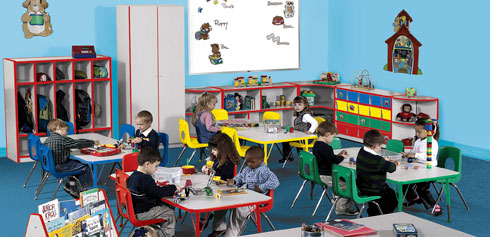
When you choose the right preschool classroom furniture, you will know right away that you have made the correct decision. When our youngest students are beginning their educational journey, and some of them are even experiencing formal education for the first time, giving them a positive experience is so important. Classroom furniture that is inviting, comfortable and appropriately sized helps students build confidence. To get the right arrangement from the beginning, you need to think about each area of the classroom, and exactly what you need to maximize its potential.
When your youngest students walk into the classroom and see that everything is just right for them, it helps them build confidence. When they can easily get in and out of their chairs themselves, and reach everything on the shelves, they learn how to do things independently, and are empowered to do more and more things themselves. So appropriately-sized chairs don’t only allow for proper blood flow, but also help develop life skills and build character.
The most important factor in choosing preschool chairs is the seat height. Children should be able to sit with their feet resting flat on the floor, and a seat at the right height allows them to do just that. When feet are resting flat on the floor, students can have healthy circulation while they sit and work, without having pressure at the back of their knees. The best chair seat height for children in a preschool classroom is a 12” seat. It might be a good idea to have a few chairs that are a bit shorter or a bit taller, to accommodate the children who are a few inches shorter or taller than average.
Getting the right fit is really important, but there are other factors to consider in order to make the right choice for your preschool classroom. Comfort and style make a big difference as well. While you definitely need some more standard preschool tables and chairs, you also want to add some variety into the space as well. Comfy soft seating will make a great addition to any learning space, and preschool is no exception. This is just the thing you need in a quiet reading nook, or a corner where students go to calm down when they are feeling overwhelmed or upset. The more comfortable and attractive the soft seating is, the more at home and welcome your students will feel. It is exceptionally important to foster those feelings toward your preschool classroom, so students will have positive associations with school from the very beginning.
preschool is a critical year for learning, which can set the tone for our students’ entire educational experience. The more we invest in making this the best experience possible, the better opportunity our students have for a future full of educational success. With furniture that fits perfectly, and cheerfully invites students into a comfortable, supportive space, we can get our students started off right. The more thought goes into furnishing each and every area of the classroom before the students come in, the more they can gain from this experience, starting from day one.
